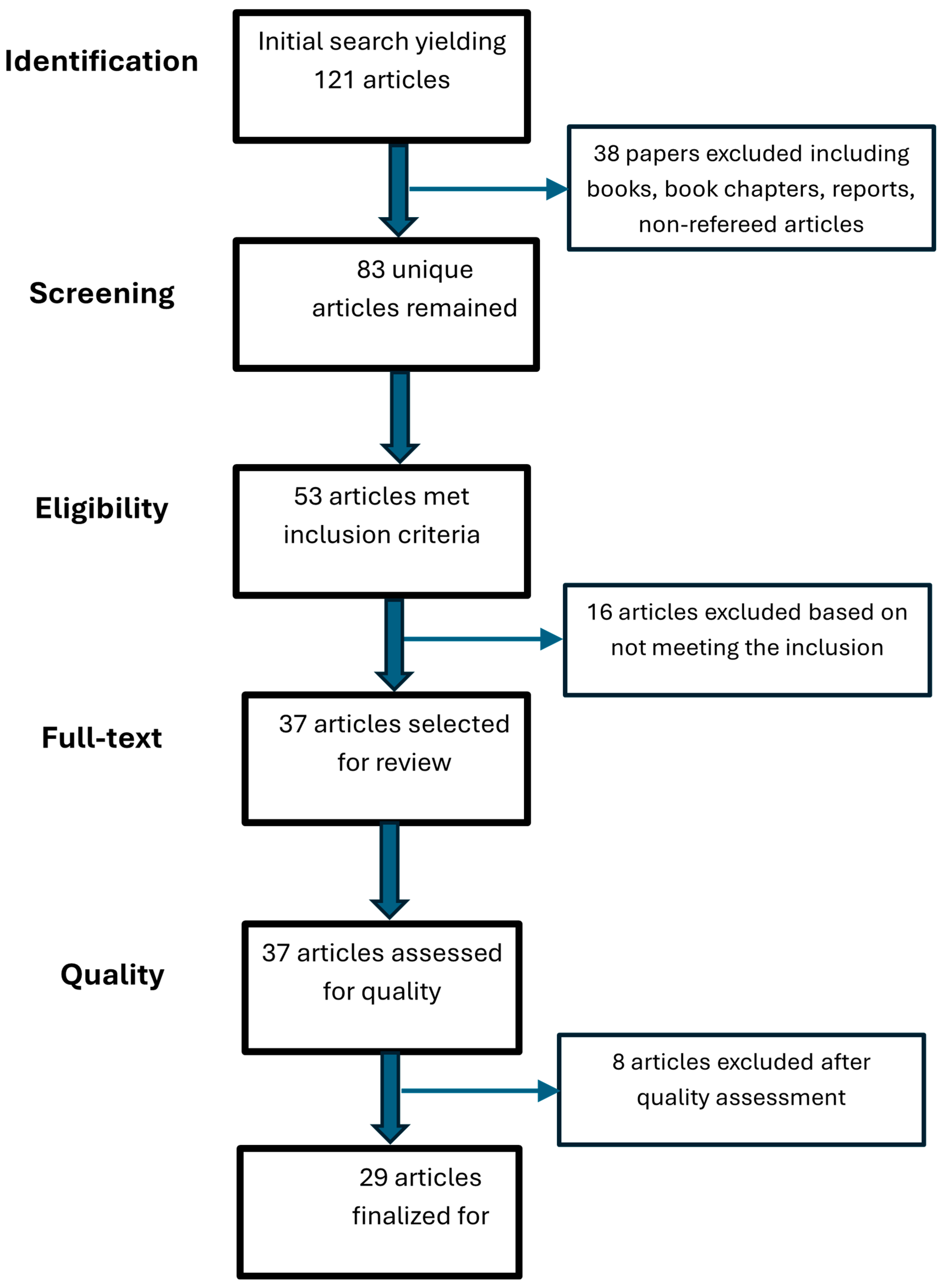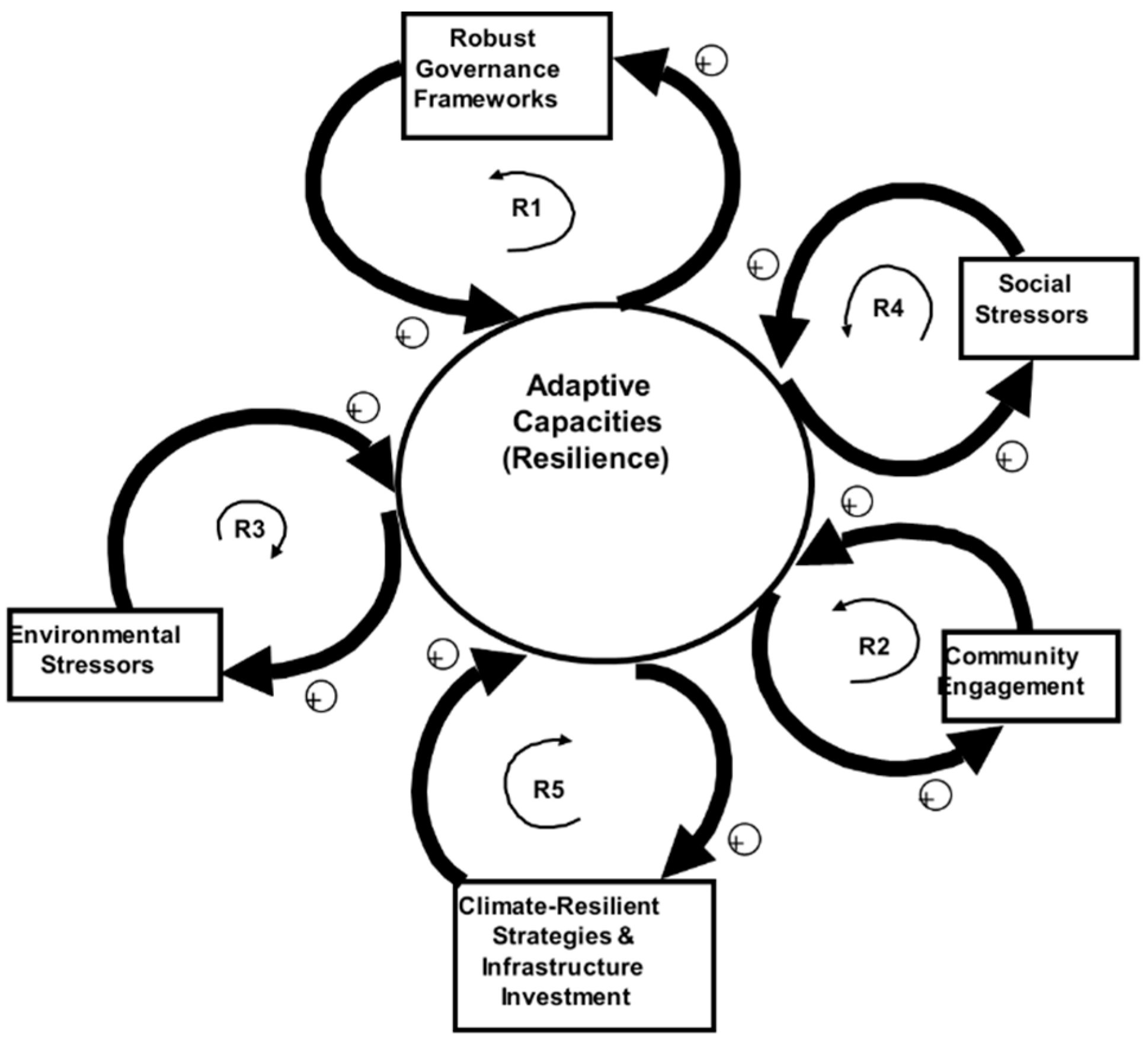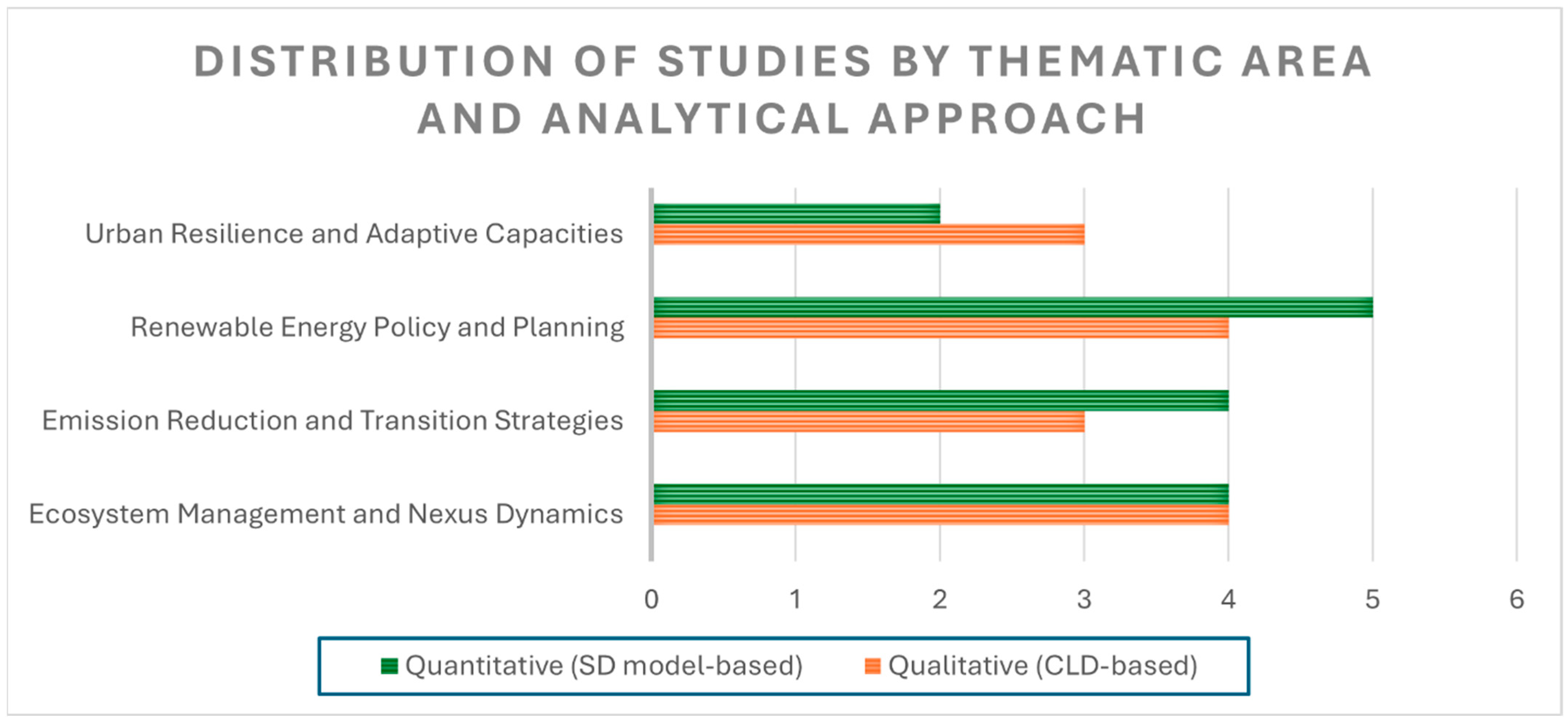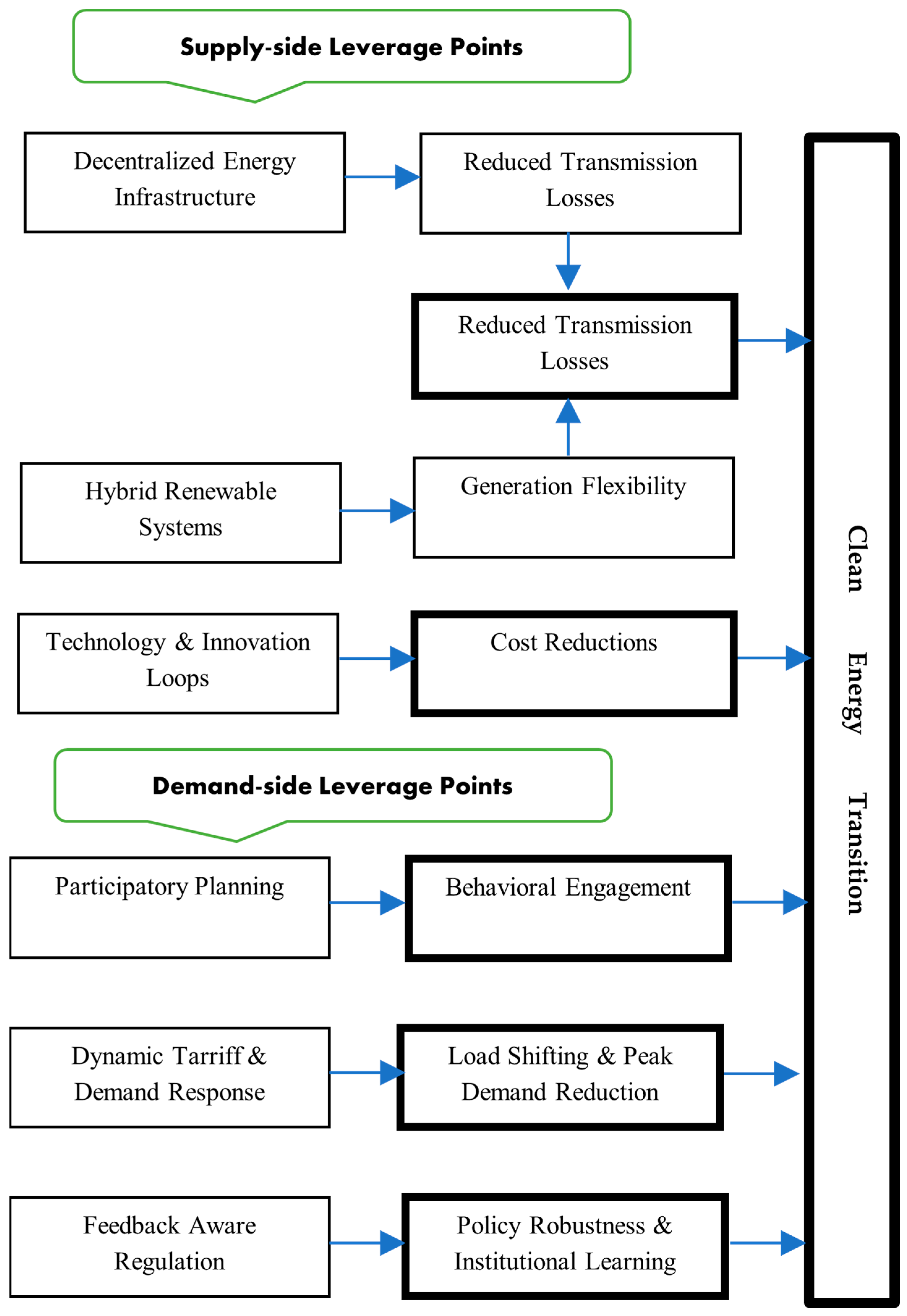Systems Thinking for Climate Change and Clean Energy
Abstract
1. Introduction
2. Literature Review: Causal Loop Diagrams in Climate and Clean Energy Systems
2.1. Overview of CLD Construction and Utilization
2.2. Mapping Feedback Structures in Climate and Energy Systems
2.3. Integrating CLDs with Quantitative Climate and Policy Models
2.4. CLDs in Ecosystem and Climate Dynamics
2.5. Summary and Gaps Identified
3. Methodology
3.1. Literature Inclusion and Exclusion Criteria
- Peer-reviewed journal articles.
- Publications from 2004 to 2024.
- Studies explicitly employing CLDs in climate or energy research.
- Emphasis on feedback loops, delays, or nonlinear dynamics.
- Non-peer-reviewed materials (e.g., commentaries, opinion pieces).
- Books and book chapters.
- Studies not focused on climate or energy systems.
- Articles without explicit CLD applications.
3.2. Literature Search Strategy
3.3. Data Extraction and Thematic Analysis
- Renewable Energy Systems: Studies focusing on CLD applications in the planning, integration, and optimization of renewable energy sources.
- Policy Analysis: Insights into policy development using CLDs to evaluate sustainable energy strategies and climate risk management.
- Ecosystem and Climate Dynamics: Applications of CLDs in understanding ecological impacts and climate system feedback.
3.4. Quality Assessment
3.5. Methodological Flowchart
4. Thematic Results and Case Applications
4.1. Renewable Energy Policy and System Dynamics
4.2. Emission Reduction and Energy Transitions
- R1: Reinforcing Loop (Fossil Fuel Use → Carbon Emissions → Fossil Fuel Use)
- 2.
- B1: Balancing Loop (Carbon Emissions → Climate Impact → Policy Pressure → Renewable Energy Adoption → Carbon Emissions)
- 3.
- R2: Reinforcing Loop (Renewable Energy Adoption → Technological Advancements → Renewable Energy Adoption)
4.3. Ecosystem Management and Resource Nexus Challenges
4.4. Urban Resilience and Adaptive Capacities
- R1: Governance and Adaptive Capacities: Robust governance frameworks—characterized by effective leadership, policies, and accountability—directly enhance the adaptive capacities of urban systems by enabling better resource management. Improved adaptive capacities create stronger urban systems that, in turn, foster further advancements in governance (e.g., through successful implementation of programs that build public trust and political stability). As an example, policies supporting renewable energy deployment leads to stronger energy resilience, which reinforces public support for governance—a vicious cycle.
- R2: Community Engagement and Adaptive Capacities: Community engagement, including public participation, education, and grassroots initiatives, contributes to enhancing adaptive capacities by fostering local innovation, awareness, and resource mobilization. As adaptive capacities improve, the community becomes more empowered, creating a virtuous cycle of active participation and shared ownership in resilience efforts. One can see as an example that a community involvement in flood preparedness programs leads to more resilient infrastructure, which further encourages public participation in environmental initiatives.
- R3: Environmental Stressors and Adaptive Capacities: Environmental stressors like extreme weather, resource scarcity, and pollution degrade adaptive capacities, leading to increased vulnerability. However, enhanced adaptive capacities can mitigate these stressors by implementing solutions such as green infrastructure, emissions reductions, and sustainable resource management. This creates a reinforcing loop where reductions in stressors allow for greater focus on strengthening adaptive capacities. For a better understanding of this reinforcing feedback loop, consider the example of a city which invests in green roofs to counter heatwaves, reducing the intensity of the stressor and allowing the city to allocate resources to further improve resilience.
- R4: Social Stressors and Adaptive Capacities: Social stressors, including inequality, urbanization, and social unrest, strain adaptive capacities by diverting resources and attention. Conversely, strong adaptive capacities can mitigate these stressors through inclusive policies, equitable resource distribution, and improved quality of life. Over time, this positive feedback reduces social tensions and strengthens resilience. As an example, affordable housing programs reduce overcrowding and stress on urban systems, which allows the city to address other social challenges effectively.
- R5: Infrastructure Investments and Resilience: Adaptive capacities enable targeted investments in climate-resilient infrastructure, such as flood defenses, renewable energy systems, and smart technologies. These investments further enhance the urban system’s resilience by reducing vulnerabilities and increasing efficiency. The cycle of investment and improvement creates a robust reinforcing loop. For example, installing solar-powered microgrids enhances energy resilience, which provides financial savings and reliability, encouraging further investments.
5. Discussion
5.1. Synthesizing Key Findings
5.2. Comparative Insights with Prior Literature
5.3. Policy Implications and Strategic Leverage Points
5.4. Limitations of CLD-Based Approaches
5.5. Future Research Directions
6. Conclusions
Funding
Data Availability Statement
Conflicts of Interest
References
- Intergovernmental Panel on Climate Change (IPCC). Climate Change 2021: The Physical Science Basis; Contribution of Working Group I to the Sixth Assessment Report; Cambridge University Press: Cambridge, UK, 2021. [Google Scholar]
- International Energy Agency (IEA). Net Zero by 2050: A Roadmap for the Global Energy Sector; International Energy Agency: Paris, French, 2025. [Google Scholar]
- Sterman, J.D. Business Dynamics: Systems Thinking and Modeling for a Complex World; McGraw-Hill: New York, NY, USA, 2000. [Google Scholar]
- Meadows, D.H. Thinking in Systems: A Primer; Chelsea Green Publishing: London, UK, 2008. [Google Scholar]
- Qudrat-Ullah, H. Understanding the Dynamics of Nuclear Power and the Reduction of CO2 Emissions: A System Dynamics Approach; Springer: Berlin/Heidelberg, Germany, 2022. [Google Scholar] [CrossRef]
- Qudrat Ullah, H. A review and analysis of green energy and the environmental policies in South Asia. Energies 2023, 16, 7486. [Google Scholar] [CrossRef]
- Ford, A. Modeling the Environment, 2nd ed.; Island Press: Washington, DC, USA, 2010. [Google Scholar]
- Crielaard, L.; Uleman, J.F.; Châtel, B.D.L.; Epskamp, S.; Sloot, P.M.A.; Quax, R. Refining the causal loop diagram: A tutorial for maximizing the contribution of domain expertise in computational system dynamics modeling. Psychol. Methods 2024, 29, 169–201. [Google Scholar] [CrossRef]
- Geels, F.W.; Ayoub, M. A socio-technical transition perspective on positive tipping points in climate change mitigation: Analysing seven interacting feedback loops in offshore wind and electric vehicles acceleration. Technol. Forecast. Soc. Change 2023, 193, 122639. [Google Scholar] [CrossRef]
- Ghorbani, A.; Nascimento, L.; Filatova, T. Growing community energy initiatives from the bottom up: Simulating the role of behavioural attitudes and leadership in The Netherlands. Energy Res. Soc. Sci. 2020, 70, 101782. [Google Scholar] [CrossRef]
- Qudrat-Ullah, H. Understanding the dynamics of electricity generation capacity in Canada: A system dynamics approach. Energy 2013, 59, 285–294. [Google Scholar] [CrossRef]
- Groundstroem, F.; Juhola, S. Using systems thinking and causal loop diagrams to identify cascading climate change impacts on bioenergy supply systems. Mitig. Adapt. Strateg. Glob. Change 2021, 26, 29. [Google Scholar] [CrossRef]
- Zellner, M.; Massey, D.; Rozhkov, A.; Murphy, J.T. Exploring the barriers to and potential for sustainable transitions in urban–rural systems through participatory causal loop diagramming of the food–energy–water nexus. Land 2023, 12, 551. [Google Scholar] [CrossRef]
- Kapmeier, F.; Greenspan, A.; Jones, A.; Sterman, J. Science-based analysis for climate action: How HSBC Bank uses the En-ROADS climate policy simulation. Syst. Dyn. Rev. 2021, 37, 333–352. [Google Scholar] [CrossRef]
- Richardson, G.P. Problems with causal-loop diagrams. Syst. Dyn. Rev. 1986, 2, 158–170. [Google Scholar] [CrossRef]
- Bouchet, L.; Thoms, M.C.; Parsons, M. Using causal loop diagrams to conceptualize groundwater as a social-ecological system. Front. Environ. Sci. 2022, 10, 836206. [Google Scholar] [CrossRef]
- Sterman, J.D. Risk communication on climate: Mental models and mass balance. Science 2008, 322, 532–533. [Google Scholar] [CrossRef]
- Jalali, M.S.; Beaulieu, E. Strengthening a weak link: Transparency of causal loop diagrams—Current state and recommendations. Syst. Dyn. Rev. 2023, 40, e1753. [Google Scholar] [CrossRef] [PubMed]
- Tidwell, V.C.; Moreland, B.D.; Zemlick, K.M. Causal loop diagramming: A critical tool for developing a shared understanding of water systems. J. Water Resour. Plan. Manag. 2020, 146, 04020095. [Google Scholar] [CrossRef]
- Mercure, J.-F.; Pollitt, H.; Bassi, A.-M.; Viñuales, J.E.; Edwards, N.R. Modelling complex systems of heterogeneous agents to better design sustainability transitions policy. Glob. Environ. Change 2015, 37, 102–115. [Google Scholar] [CrossRef]
- Ioannou, A.E.; Laspidou, C.S. Resilience analysis framework for a water–energy–food nexus system under climate change. Front. Environ. Sci. 2022, 10, 820125. [Google Scholar] [CrossRef]
- Gudlaugsson, B.; Abi Ghanem, D.; Dawood, H.; Pillai, G.; Short, M. A qualitative based causal-loop diagram for understanding policy design challenges for a sustainable transition pathway: The case of Tees Valley region, UK. Sustainability 2022, 14, 4462. [Google Scholar] [CrossRef]
- Fiddaman, T. Exploring policy options with a behavioral climate-economy model. Syst. Dyn. Rev. 2002, 18, 243–267. [Google Scholar] [CrossRef]
- Olivar-Tost, G.; Valencia-Calvo, J.; Castrillón-Gómez, J.A. Towards decision-making for the assessment and prioritization of green projects: Integrating participatory modeling and system dynamics. Sustainability 2020, 12, 10689. [Google Scholar] [CrossRef]
- Liu, Y.; Li, Q.; Wang, J. Review of system dynamics in nexus contexts: Quantifying causal loop diagram adoption and methodological rigor. Environ. Model. Softw. 2023, 161, 105504. [Google Scholar] [CrossRef]
- Luna-Reyes, L.F.; Andersen, D.F. Collecting and analyzing qualitative data for system dynamics: Methods and models. Syst. Dyn. Rev. 2003, 19, 271–296. [Google Scholar] [CrossRef]
- Valkering, P.; Yücel, G.; Gebetsroither-Geringer, E.; Markvica, K.; Meynaerts, E.; Frantzeskaki, N. Accelerating transition dynamics in city regions: A qualitative modeling perspective. Sustainability 2017, 9, 1254. [Google Scholar] [CrossRef]
- Qudrat-Ullah, H. Exploring the Dynamics of Renewable Energy and Sustainable Development in Africa; Springer: Berlin/Heidelberg, Germany, 2023. [Google Scholar] [CrossRef]
- Naeem, K.; Zghibi, A.; Elomri, A.; Mazzoni, A.; Triki, C. A literature review on system dynamics modeling for sustainable management of water supply and demand. Sustainability 2023, 15, 6826. [Google Scholar] [CrossRef]
- Sterman, J.D.; Booth Sweeney, L. Understanding public complacency about climate change: Adults’ mental models of climate change violate conservation of matter. Clim. Change 2007, 80, 213–238. [Google Scholar] [CrossRef]
- Sušnik, J.; Vamvakeridou-Lyroudia, L.S.; Savic, D.A.; Kapelan, Z. Integrated system dynamics modelling for water-scarce city planning and water-sensitive urban design. Environ. Model. Softw. 2013, 41, 15–29. [Google Scholar] [CrossRef]
- Giordano, R.; Osann, A.; Henao, E.; López, M.L.; Piqueras, J.G.; Nikolaidis, N.P.; Lilli, M.; Coletta, V.R.; Pagano, A. Causal loop diagrams for bridging the gap between Water-Energy-Food-Ecosystem Nexus thinking and Nexus doing: Evidence from two case studies. J. Hydrol. 2025, 650, 132571. [Google Scholar] [CrossRef]
- Chen, C.; Wei, Z.; Shi, L.; Wu, G. Exploring the dynamics of urban resilience using system dynamics modeling: A case study of flood management in Shanghai. Environ. Res. 2020, 185, 109318. [Google Scholar] [CrossRef]
- Alvarado, M.; Garrett, J.; Fullam, J.; Lovell, R.; Guell, C.; Taylor, T.; Garside, R.; Zandersen, M.; Wheeler, B.W. Using causal loop diagrams to develop evaluative research propositions: Opportunities and challenges in applications to nature-based solutions. Syst. Dyn. Rev. 2023, 39, 411–429. [Google Scholar] [CrossRef]
- Lawrence, S.; Herber, D.R.; Shahroudi, K.E. Leveraging system dynamics to predict the commercialization success of emerging energy technologies: Lessons from wind energy. Energies 2025, 18, 2048. [Google Scholar] [CrossRef]
- de Gooyert, V.; Rouwette, E.; van Kranenburg, H.; Freeman, E.; van Breen, H. Sustainability transition dynamics: Towards overcoming policy resistance. Technol. Forecast. Soc. Change 2016, 111, 135–145. [Google Scholar] [CrossRef]
- Qudrat-Ullah, H.; Kayal, A. (Eds.) Climate Change and Energy Dynamics in the Middle East; Springer: Berlin/Heidelberg, Germany, 2019. [Google Scholar] [CrossRef]
- Vennix, J.A.M. Group Model Building: Facilitating Team Learning Using System Dynamics; Wiley: New York, NY, USA, 1996. [Google Scholar]





| Thematic Area | Representative Studies | Key Insights | Policy/Practical Implications |
|---|---|---|---|
| Renewable Energy Integration | [6,8,9,11] | CLDs reveal how subsidies, infrastructure, and social capital drive renewable adoption dynamics | Targeted subsidies, infrastructure investment, community engagement crucial for uptake |
| Grid Stability & Demand Management | [12,14,15] | CLDs help optimize supply–demand balance, storage, and consumer behavior to enhance grid resilience | Promote energy storage, demand response, and dynamic pricing |
| Feedback-Driven Policy Analysis | Bouchet et al. (2022); Sterman (2008); Jalali & Beaulieu (2023); [11,16,18] | Feedback-aware policies improve resource sustainability, reduce rebound effects, and boost stakeholder buy-in | Adopt adaptive policies with transparent communication |
| Ecosystem & Climate Dynamics | [9,15,25,27] | CLDs illuminate feedback linking land use, water resources, biodiversity, and climate adaptation | Integrate ecological feedback into climate and conservation policy |
| Climate Impacts on Renewables | [6,28] | Climate variability affects renewable efficiency and availability, posing challenges for grid stability | Invest in adaptive infrastructure and diversify energy portfolios |
| Key Study | Focus Area | Insights Gained | Impact on Policy Decisions |
|---|---|---|---|
| [28] | Renewable energy in Africa | Interplay between policy, supply, and environmental outcomes | Identified leverage points for sustainability |
| [14] | Energy storage and grid stability | Feedback effects on energy storage and grid reliability | Accelerated storage deployment through policy |
| Geels & Ayoub (2023) [9] | Transition pathways in energy systems | Socio-technical feedback loops driving transitions in renewable energy adoption | Informed policies for phased transitions and stakeholder alignment |
| [12] | Community-driven renewable programs | Adaptive governance in community-based renewable energy programs | Promoted participatory policy frameworks for energy access |
| [8] | Circular economy in energy systems | Interaction of renewable energy and resource efficiency through closed-loop systems | Shaped policies encouraging integration of renewable energy and recycling |
| [18] | Energy equity and accessibility | Feedback loops impacting equitable access to renewable energy resources | Enhanced policies ensuring equitable energy distribution |
| [15] | Net-zero emissions strategies | Long-term system dynamics of decarbonization efforts | Developed timelines and pathways for achieving carbon neutrality |
| [13] | Urban energy resilience | Systemic feedback between urban planning and energy resilience | Strengthened urban policies integrating renewable energy with climate goals |
| Key Study | Focus Area | Insights Gained | Impact on Policy Decisions |
|---|---|---|---|
| [17] | Fossil fuel emissions and feedback structures | Identified reinforcing loops (e.g., fossil fuel lock-in) and balancing loops (e.g., climate-policy response) | Supported systems-based climate policy modeling and highlighted feedback delays in emission reductions |
| [29] | U.S. energy transition modeling | Used CLDs to simulate energy transition scenarios with policy, technology, and emission feedback loops | Informed scenario-based energy planning with phased fossil fuel decline and renewable uptake |
| [7] | Climate policy and system delays | Highlighted time delays between emissions, climate impacts, and policy feedback | Encouraged long-term planning horizons and proactive policy intervention despite delayed system responses |
| [7] | Carbon policy in electric power systems | Modeled policy impact using CLDs to track emissions, pricing, and adoption of renewables | Influenced regulatory frameworks for emission caps and renewable energy incentives |
| [23] | Integrated climate–economy feedback | Demonstrated how economic and technological factors reinforce or balance climate outcomes via policy | Shaped integrated assessment models (IAMs) that support emission pricing and innovation subsidies |
| [23] | Technological change and policy design | Showed how R&D investment feedback affect future mitigation costs and energy adoption | Informed flexible, adaptive policies that support clean tech innovation and cost curve shifts |
| [30] | Public understanding of climate dynamics | CLD-based simulations revealed public misperceptions of emission lags and feedback | Led to climate communication strategies aimed at improving policy support through better systems literacy |
| Study | Focus Area | Insights Gained | Applications |
|---|---|---|---|
| [31] | Water–energy–food nexus in urban areas | Trade-offs and synergies in resource management | Informed integrated urban planning |
| [32] | Social-ecological systems | Dynamic interactions in ecosystem resilience | Adaptive ecosystem management |
| [16] | River system dynamics | Feedback mechanisms between hydrological cycles and biodiversity | Improved strategies for river ecosystem conservation |
| [9] | Transition pathways in ecosystems | Socio-ecological feedback loops driving system transitions | Policy recommendations for ecosystem restoration |
| [21] | Urban ecosystem services | CLD modeling of urban ecosystem service provision and demand | Strengthened urban sustainability strategies |
| [12] | Ecosystem-based governance | Adaptive governance in managing fragmented ecosystems | Participatory conservation approaches |
| [25] | Climate adaptation strategies | Feedback loops in climate adaptation and biodiversity preservation | Resilient ecosystem planning for climate impacts |
| [29] | Desertification and land degradation | CLD analysis of land use and resource depletion dynamics | Strategies for sustainable land management |
| [15] | Circular economy and ecosystems | Interactions between material flows and ecosystem health | Policy integration of circular economy principles |
| [13] | Urban resilience and ecosystem services | Feedback between urban planning and ecosystem health | Integrated urban and ecological resilience frameworks |
| [17] | Climate systems modeling | Long-term dynamics of greenhouse gas emissions and climate impacts | Global climate policy formulation |
| [27] | Adaptive strategies for ecosystem dynamics | Modeling tipping points in ecosystem resilience | Early warning systems for ecosystem threshold management |
Disclaimer/Publisher’s Note: The statements, opinions and data contained in all publications are solely those of the individual author(s) and contributor(s) and not of MDPI and/or the editor(s). MDPI and/or the editor(s) disclaim responsibility for any injury to people or property resulting from any ideas, methods, instructions or products referred to in the content. |
© 2025 by the author. Licensee MDPI, Basel, Switzerland. This article is an open access article distributed under the terms and conditions of the Creative Commons Attribution (CC BY) license (https://creativecommons.org/licenses/by/4.0/).
Share and Cite
Qudrat-Ullah, H. Systems Thinking for Climate Change and Clean Energy. Energies 2025, 18, 4200. https://doi.org/10.3390/en18154200
Qudrat-Ullah H. Systems Thinking for Climate Change and Clean Energy. Energies. 2025; 18(15):4200. https://doi.org/10.3390/en18154200
Chicago/Turabian StyleQudrat-Ullah, Hassan. 2025. "Systems Thinking for Climate Change and Clean Energy" Energies 18, no. 15: 4200. https://doi.org/10.3390/en18154200
APA StyleQudrat-Ullah, H. (2025). Systems Thinking for Climate Change and Clean Energy. Energies, 18(15), 4200. https://doi.org/10.3390/en18154200








